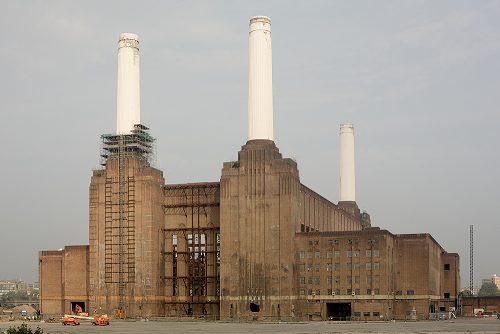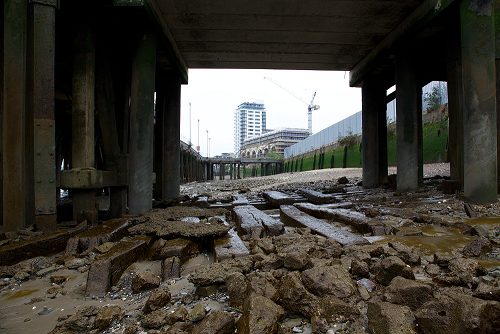Battersea Power Station, Deptford Dockyard, Grimsby Ice Factory and Sulgrave Manor in Northamptonshire are the UK sites listed today on the 2014 World Monuments Watch.
They join a diverse group of 67 sites from 41 countries and territories across the world, including the city of Venice, the Ancient Irrigated Terraces of Battir outside Bethlehem and thousands of traditional gas lamps in Berlin. These important but ailing sites date from prehistory to the twentieth century. Today they are all at risk and face an uncertain future. Their needs are different – affected by the forces of nature and the impact of social, political and economic change – but they all require urgent support.
The World Monuments Watch draws international attention and support for some of the world’s most remarkable and fragile cultural heritage. The 2014 Watch exposes a series of thematic global threats: conflict and catastrophe, lack of resources, development pressures (such as urban growth, rural abandonment and unsustainable tourism), climate change and loss of cultural traditions are having a significant impact on our irreplaceable cultural heritage. The Watch squarely addresses these concerns.
Dr Jonathan Foyle, Chief Executive of World Monuments Fund Britain says, “Every two years, the World Monuments Watch reminds us the world around us changes faster than ever before. Change is inevitable, but it needs to be carefully managed so that we carry the best of the past into the future, and minimise the destruction of our record as a species. So we invite everyone to join us in supporting the champions of special places that need a helping hand to stay useful and beautiful.”
Battersea Power Station, London
Battersea Power Station is one of London’s most iconic landmarks and an unforgettable presence on the capital’s skyline. The building is a twentieth-century feat of architecture and engineering and a favourite icon of popular culture – it featured in the 2012 Olympic closing ceremony and was visited by over 38,000 people as part of London’s recent Open House weekend.
 Battersea Power Station was first Watch listed by World Monuments Fund in 2004. Ten years on, it is still a building at risk. No substantive repair works have been carried out since 1983, and in 2007 the power station was upgraded to Grade II* status on account of its powerful architectural and historic significance and the degree of loss the building has suffered.
Battersea Power Station was first Watch listed by World Monuments Fund in 2004. Ten years on, it is still a building at risk. No substantive repair works have been carried out since 1983, and in 2007 the power station was upgraded to Grade II* status on account of its powerful architectural and historic significance and the degree of loss the building has suffered.
WMF will keep the spotlight on current redevelopment plans for the power station site and the impact existing proposals will have on the future of this heritage asset. The rebuilding of Battersea’s iconic chimneys has been the focus of much media attention. With demolition and subsequent reconstruction plans scheduled to start on the chimneys in 2014, WMF’s renewed focus on the site supports the campaign to ensure that these icons are rebuilt and the famous South London skyline is reinstated as soon as possible.
Deptford Dockyard and Sayes Court Gardens, London
In 1513 Henry VIII founded the Royal naval Dockyard at Deptford, and the King’s Yard became the foremost Royal dockyard of the Tudor period. Hundreds of warships and trading vessels were built here, including ships for exploration, science and empire. The Mary Rose was launched from Deptford in 1517, and the dockyard remained a naval powerhouse for another 350 years. The site also includes John Evelyn’s seventeenth-century garden at Sayes Court, one of the most famous and revolutionary gardens of its time.
The majority of the area has been concreted over in past decades, but recent excavations have revealed the dockyard’s extensive maritime heritage. Many large structures survive intact below (and in some cases above) ground level. However, the current low-level designation of the site remains unchanged despite this wealth of new archaeological data, and Deptford’s status as a heritage asset remains disproportionate with the survival of the fabric.
2013 is Deptford’s 500th anniversary, and today the site awaits residential redevelopment. Yet Deptford’s most imminent threat comes from the failure of existing proposals to fully acknowledge and respect the heritage assets that the site has to offer. Incorporating the extensive archaeology and combining this with unique public spaces has the potential to strengthen Deptford’s local identity whilst securing this lost piece of the Thames jigsaw. It would also improve awareness of the little-known existence and overlooked history of the dockyard and gardens on a national stage.
Grimsby Ice Factory and Kasbah
The Grimsby Ice Factory is a unique survivor of the Victorian industrial era. The Grade II* structure is the earliest and largest-known surviving ice factory in the world, and the sole example from this period to retain its machinery. In its heyday Grimsby was one of the busiest fishing ports in the world, and its ice factory was built with an attention to detail worthy of the best Victorian industrial architecture.
 Today the deteriorating ice factory is a neglected local landmark in one of the most deprived parts of the UK. When the fishing industry declined, so too did the surrounding area, and now this important but ailing building is in need of restoration and revival.
Today the deteriorating ice factory is a neglected local landmark in one of the most deprived parts of the UK. When the fishing industry declined, so too did the surrounding area, and now this important but ailing building is in need of restoration and revival.
The factory and surrounding docks, known as the Kasbah, present a valuable opportunity for a much-needed regeneration project within Grimsby, and current proposals recognise the potential of the building complex to become a cultural and leisure hub for the town. In an important first step, the Great Grimsby Ice Factory Trust will seek to take legal ownership of this magnificent industrial building.
Sulgrave Manor, Northamptonshire
Sulgrave is an important manor house of c.1540 built by the ancestors of George Washington. A sixteenth-century shield with the Washington stars and stripes which are thought to have informed the flag of the United States still remains above the door. The house was purchased on behalf of the citizens of the United States and England in 1914, as a gift to mark the centenary of the 1814 Treaty of Ghent, which established peace between the nations. 2014 will mark the bicentenary.
Sulgrave Manor is representative of the challenges facing many sites under the care of small trusts across the UK. Through not being able to generate enough revenue they are often unable to keep up with the maintenance needs of the building. In Sulgrave’s case, the fabric of the building is in a poor state of repair, and the unique collections housed at the site are being actively threatened. As a result, the Trust faces the prospect of selling parts of its historic estate.
A proactive heritage-led business plan would help develop a focused course of action for the site and would stave off the impending sale of a row of historic thatched cottages, instead using these assets and others to bolster the Trust’s income stream. It would also identify ways of improving the future sustainability of the site, so that Sulgrave can once again be a valuable cultural and educational resource for local, national and international visitors.
